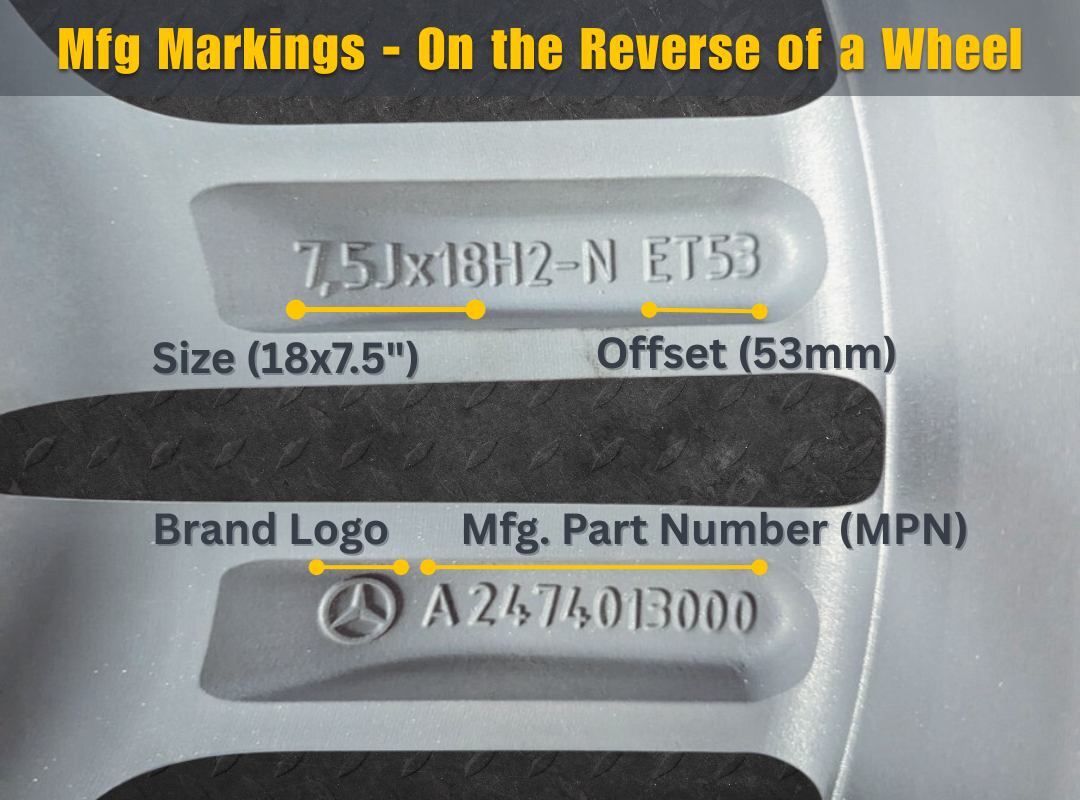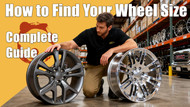How to Find Your OEM Wheel Size: Complete Guide
Posted by Hermes Golf on Oct 14th 2025
How to Find Your OEM Wheel Size: Complete Guide
Need to know your wheel size or OEM wheel size? Finding your rim size takes just minutes when you know where to look. Check the backside of your wheel for stamped numbers, read your tire sidewall, or measure directly. We'll show you exactly how to identify your factory original wheel specifications and why getting the right rim sizes matters for your vehicle's performance and safety.
What Is My Wheel Size and Why Does It Matter?
You're staring at your car, wondering what size wheels you actually have. Maybe you need replacements, or you're curious about upgrades. Either way, figuring out your wheel size doesn't have to feel like solving a puzzle.
Your OEM wheel size matters more than you think. Get it wrong, and you're looking at poor handling, incorrect speedometer readings, or wheels that simply won't fit. Get it right, and you'll have peace of mind knowing your ride performs exactly as it should.
Here's the good news: finding your rim size takes about three minutes if you know where to look. Or, if you want instant answers, use our free wheel fitment calculator—just enter your vehicle's year, make, and model.
Three Reliable Ways to Find Your Wheel Size
You've got options. Let's break down the most accurate methods to discover your factory original wheel specifications.
Read Your Tire Sidewall First
This is your quickest and most reliable starting point. Look at your tire sidewall for a code like "265/50R16" or "225/45R17".
Those last two digits after the "R" tell you everything. R16 means 16-inch wheel diameter. R17 means 17 inches. R20 means 20 inches. You get the picture.
The "R" just indicates radial construction. The number following it? That's your rim size in inches, guaranteed accurate.
Here's the limitation: Your tire shows diameter but not wheel width. For complete specs, you'll need to check the rim itself or contact your dealer.
Check the Backside of Your Wheel
If your wheel is off the car, flip it over and look at the spokes. This is where manufacturers stamp the complete wheel size information.
You'll see numbers like "16x7" or "18x7½" etched into the metal. The first number is your wheel diameter (16 or 18 inches). The second number is your wheel width (7 or 7.5 inches).
Alloy wheels show this info on the backside between the spokes. Steel wheels sometimes display it on the front face instead.
You might also find the OEM number, country of origin, and manufacturer's mark. That's your wheel's complete identification.

Call Your Car Dealer's Service Department
This method gets you factory-accurate information straight from the source. Your dealer's service department has access to complete OEM wheel specifications for every vehicle they sell.
Just call them with your VIN number handy. They'll tell you the exact wheel size, rim specifications, and even the OEM part number for your stock wheels.
This approach works perfectly when markings are worn off or when you need to verify specs before buying replacement wheels.
Understanding Wheel Size Markings
Let's decode what those numbers actually mean. When you see "18x7½" stamped on your stock wheel, you're looking at two measurements.
The diameter comes first. That's the distance across the wheel from edge to edge—18 inches in this case. This number must match your tire specifications or nothing fits together properly.
The width comes second. That 7½ means your rim is seven and a half inches wide from inside edge to inside edge. This affects which tire widths you can safely mount.
Some wheels flip the script and show measurements in millimeters. You'll need to divide by 25.4 to convert to inches. So a 457mm diameter equals 18 inches.
Why Similar-Looking Wheels Aren't Always the Same Size
Here's where things get tricky. Two stock rims can look identical but have different specs.
Your neighbor's Honda might have 16-inch wheels that look exactly like your 17-inch OEM wheels. Same design, same finish, different size. Install the wrong ones and you're asking for trouble.
That's why you can't eyeball it. You need concrete numbers from the wheel itself, the tire, or accurate measurements.
This confusion happens constantly with used wheels and reconditioned rims. A visual match doesn't guarantee a fitment match.
Converting Tire Width to Estimate Wheel Size
Want a rough estimate of your wheel width? Your tire sidewall gives you a clue.
Take that first number in the tire code—let's say "225" from "225/50R16". That's the tire width in millimeters.
Divide 225 by 25.4 to get inches. You'll land around 8.9 inches. Your actual rim width runs narrower than this—probably 7 or 7.5 inches for that tire size.
It's not precise, but it gets you in the ballpark. For exact numbers, check the backside of the wheel or talk to a wheel specialist.
When to Call the Experts
Sometimes you need backup. Maybe your wheel size markings are worn away. Perhaps you're comparing multiple stock wheels and can't tell them apart.
That's when wheel pros earn their keep. Experienced teams know every OEM wheel variation across makes and models. They can identify your rim size by sight or through your vehicle's specs.
Don't want to guess? Use our free wheel fitment calculator to instantly look up your exact factory specifications. Just plug in your vehicle's year, make, and model—the database does the rest.
Professional wheel specialists also help with trickier situations—like determining offset (ET), center bore, or thread size. These specs matter just as much as basic diameter and width for proper fitment.
Whether you're shopping for new take-offs, reconditioned replacements, or premium aftermarket options, expert guidance saves you from costly mistakes.
Finding Quality Replacement Wheels
Once you know your wheel size, you've got choices. Your factory original wheel specs open doors to both OEM replacements and quality aftermarket options.
Certified aftermarket wheels offer excellent value. Look for TUV, JWL, VIA, SAE, or DOT certifications—these aren't just fancy letters. They mean the wheels passed rigorous safety and quality standards.
Premium replicas often match OEM wheel specifications perfectly while costing significantly less. They come with structural warranties and finish guarantees. Industry pros trust them. Customers love them.
You're not sacrificing quality for price. You're making a smart choice backed by certifications and warranties.
Quick Reference: Where to Find Each Measurement
For wheel diameter:
- Tire sidewall (the last 2 digits after "R")
- Backside of the wheel (number before "x")
- Dealer service department (via VIN lookup)
For wheel width:
- Backside of the wheel (number after "x")
- Front face (on steel wheels)
- Dealer service department (via VIN lookup)
For complete specs including offset:
- Backside spoke stampings
- Vehicle owner's manual
- Manufacturer door jamb sticker
- Dealer service department with VIN
- Professional wheel database lookup
Frequently Asked Questions
What does 18x7 mean on a wheel?
The first number (18) is the wheel diameter in inches. The second number (7) is the wheel width in inches. So an 18x7 rim measures 18 inches across and 7 inches wide.
Can I tell my wheel size just by looking at my tire?
You can find the wheel diameter from your tire sidewall—look for the number after "R" like R16 or R17. But the tire won't show you wheel width. You need to check the rim itself for complete wheel size information.
Where exactly is the wheel size stamped on my rim?
On alloy wheels, check the backside of the wheel between the spokes. On steel wheels, look at the front side or face. The numbers appear as something like 16x7 or 17x7½.
Why can't I just use wheels that look the same as mine?
Stock rims often look identical but have different sizes. Your OEM wheel might be 16 inches while a similar-looking one is 17 inches. Wrong rim size causes handling problems, incorrect speedometer readings, and potential safety issues.
Do aftermarket wheels match OEM quality?
Certified aftermarket wheels with TUV, JWL, VIA, SAE, or DOT approval meet strict safety standards. Premium replicas often match OEM wheel specs exactly and include structural and finish warranties. Both options offer reliable performance.
What's the difference between wheel diameter and wheel width?
Wheel diameter measures straight across the rim from edge to edge—that's your tire size compatibility number. Wheel width measures how wide the rim is from inside lip to inside lip. Both measurements matter for proper fitment.
Can I measure my wheel size without removing the tire?
Yes. Check your tire sidewall for diameter (the number after R). For wheel width, look at the backside of the wheel through the spokes, or check the face if it's a steel rim. Most OEM wheels stamp this info where you can see it.
What if my wheel size numbers are worn off?
Check your tire sidewall first—the last two digits after "R" show your wheel diameter (R16 = 16 inches). For complete specs including width, call your car dealer's service department with your VIN number, use our free wheel fitment calculator, or contact a wheel specialist who can identify your factory original wheel by vehicle make, model, and year.

 US Dollars
US Dollars
